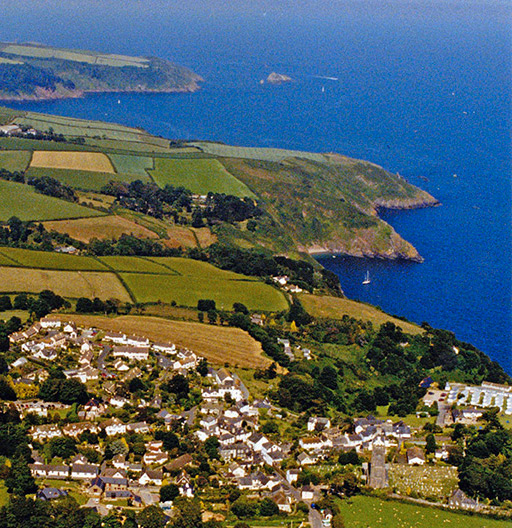The first records of Stoke Fleming appear in the Domesday Book of 1086 under its Saxon name of Stoc. At the time of the Norman Conquest in 1066 it was held by Ansger, but later passed to Walter of Douai as a spoil of war. In 1192 the manor passed to Richard the Fleming, from whom the village gained its present name. The village pub, the Green Dragon, is first recorded in 1170, and was probably built as accommodation for the artisans who were building the church, a common practice in those times.
The Carew family built a manorial hall on a site along Rectory Lane from the Green Dragon, where Manor Court now is, and occupied it for 300 years. In the 15th century the family moved to Dartmouth and the hall became a ruin.
In 1404 a French force of 2,000 knights, plus archers and men at arms, set sail to attack Dartmouth. Most landed at Slapton with the intention of marching overland to attack the town from the rear, its sea defences being too strong for a frontal attack.

One obstacle lay in their path – Blackpool marsh. This boggy area was bounded on one side by the sea and on the other by thickly wooded hills. As they moved to cross the marsh a hastily assembled English force of several thousand, many of them townspeople from Dartmouth, lined up on the other side. As the French approached they came under fire from English archers.
Weighed down by the heavily armoured knights their horses struggled to make the crossing. In the fierce fight that ensued the French army was destroyed, and all who were not killed were taken prisoner. These were presented to the king to be ransomed, and the party who delivered them
“Returned with their purses full of gold.”
In the 18th and 19th centuries the stream that runes down Blackpool Valley to Blackpool Sands was used to power a series of cornmills that ground corn for all the farms in the area. The names of the houses in Blackpool Valley – Embridge Mill, Middle Mill and Blackpool Mill – are a reminder of their original use.
In 1850 a National School was established at what is now Pump Cottage, charging a halfpenny a week to educate the children of labourers, one penny for those of tradesmen and sixpence for the children of farmers.
In the 1870s George Bidder built Stoke House, at the entrance to which a plaque commemorates the man known as the Calculating Boy, who began his career being exhibited at fairs by his father because of his astonishing powers of mental arithmetic. Subsequently he had a university education and became an engineer working with the Stephenson brothers, building many of the early railways.
During the Second World War American forces used the beaches of Start Bay as a practice area for the D-Day Normandy landings. Blackpool Sands was used as a logistics area, and landing craft assembled in the River Dart. The civilan population of an area stretching from Strete to Start Point was evacuated, and the beaches of Slapton Sands were used for the practice assaults, many using live ammunition.
In April a convoy approaching the beaches for one of these assaults, codenamed Tiger, was attacked by German E-boats. Two ships were sunk and more than 700 men lost their lives. A memorial to the incident stands halfway along Slapton Sands.
